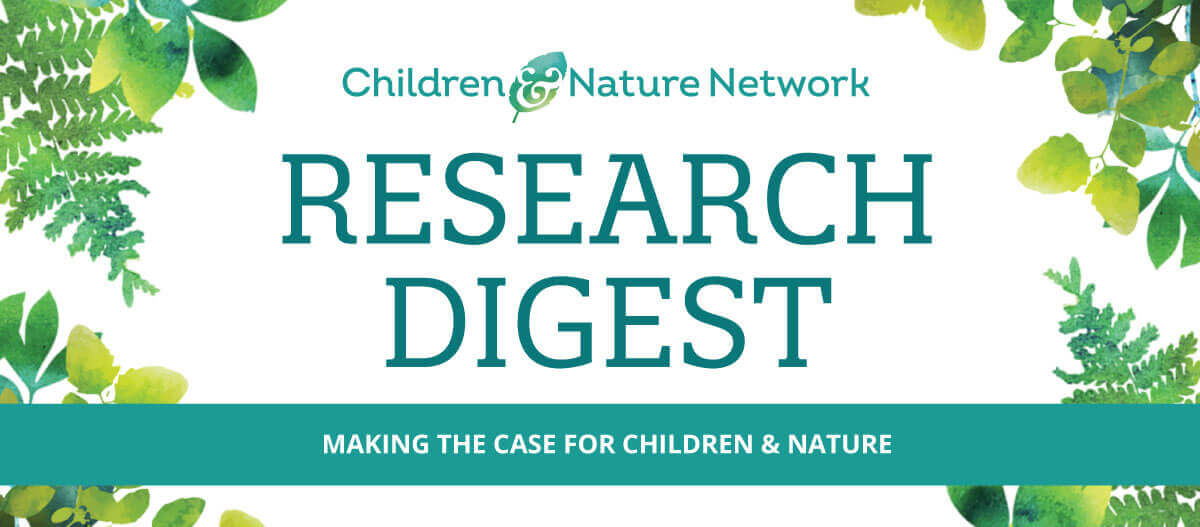SYSTEMATIC REVIEWS
Across the systematic literature reviews reported below, we see that nature exposure, nature-related experiences, and nature-based learning can promote the health and well-being of children and young people. Some of the outcomes that nature can impact include physical health outcomes (e.g., physical activity), mental health outcomes (e.g., stress reduction) and social-emotional development (e.g., self-esteem, confidence, resilience).
A common refrain of the authors highlighted below was that the findings reported in the studies they reviewed tended to be inconsistent, and that included studies were methodologically somewhat weak, utilized different or unclear definitions of either nature exposure or outcomes of interest, and employed inconsistent methods of measuring either nature or child outcomes.
Some studies showed that the relationship between nature and positive outcomes is stronger for children from communities experiencing economic disadvantage. There are broader implications of this finding for reducing inequities given that more disadvantaged neighborhoods tend to have fewer or lower-quality public open spaces.
A systematic review of the literature highlights the potential positive impact of nature-based learning for primary school-aged children
Twenty quantitative studies involving a total of 3,283 primary-age children from a variety of (mostly Western) countries documented a range of positive outcomes associated with nature-based learning in five outcome categories: physical activity, mental health and well-being, education, engagement, and social. Of these, educational outcomes – which were consistently positive – were the most commonly measured. Overall, the included studies tended to be somewhat weak, methodologically, and did not use a consistent definition or implementation of nature-based learning.
Miller, Kumar, Pearce, & Baldock, 2021. The outcomes of nature-based learning for primary school aged children: A systematic review of quantitative research.
Positive associations between nature contact and children’s health supports advocacy for equitable nature access
This review of 298 studies investigated nature exposure’s effect on health outcomes and behaviors as well as academic outcomes. There was a strong association between residential greenspace and improved health especially for physical activity and mental health outcomes. Greenspaces closer to the child’s home and school had the strongest evidence. The findings provide an evidence-base to advocate for policies and practices that support equitable access to nature for children.
Fyfe-Johnson et al., 2021. Nature and children’s health: A systematic review.
Greenspace exposure can promote youth development outcomes, but more research is needed in low- and middle-income countries
Twenty-eight studies involving youth growing up in places with more greenspaces found an association with youth developmental outcomes including positive results in cognitive development, mental health and well-being, and attention and behavior. Contradictory results were found for associations with allergy and respiratory, and obesity and weight; and those studies were also noted as being low quality. The authors noted that more longitudinal studies are needed, as well as studies that include low-income, non-White, and non-Western populations.
Sprague, Bancalari, Karim, & Siddiq, 2022. Growing up green: a systematic review of the influence of greenspace on youth development and health outcomes.
Nature play may positively impact children’s health and development, particularly in the areas of physical activity and cognitive development
Findings from 16 quantitative primary research studies of 2- to 9-year-olds published from 2001 through 2018 were included in a review supporting the idea that nature play has a positive impact on children’s levels of physical activity, health-related fitness, motor skill, cognitive learning, and social and emotional development. The strongest evidence suggested nature play positively impacts physical activity. While cognitive improvements were reported, the studies were noted to have significant methodological concerns.
Dankiw et al., 2020. The impacts of unstructured nature play on health in early childhood development: A systematic review.
Empirical research over the last 40 years identifies positive associations between nature activities and wellbeing in children and youth
This review of 14 qualitative and quantitative studies between 1978 and 2018 assessed the effects of nature-related experiences on the well-being of children and youth. The synthesis found five areas that cover a range of well-being outcomes: 1) self-esteem and confidence, 2) positive and negative affect, 3) stress reduction and restoration, 4) social benefits, and 5) resilience. Overall, some promising benefits of well-being after a brief exposure to nature were found, but there were also some inconsistencies in reported outcomes.
Roberts, Hinds, & Camic, 2019. Nature activities and wellbeing in children and young people: A systematic literature review.
Greater amounts of greenspace appear to have a positive impact on the mental well-being of adolescents
The findings from 14 studies of youth aged 10 to 19 years old indicate positive associations between residential greenspace exposure and adolescents’ mental well-being, such as less depressive symptoms and distress, improvement in mental health and behavior, and particularly improved mood and decreased stress. Findings were inconsistent, however, possibly related to the studies’ usage of different greenspace and mental well-being outcome measures.
Zhang et al., 2020. The association between green space and adolescents’ mental well-being: A systematic review.
Improving the quantity and quality of public open space in disadvantaged neighborhoods may help reduce mental health inequities
This review of 14 studies investigating associations between the neighborhood-built environment and young children’s mental health found that nature and public open space in neighborhoods plays an important role in the mental health of young children. Some evidence suggests improving the quantity and quality of public open space in low-income neighborhoods may help reduce mental health inequities. Two of the three studies making comparisons across levels of socio-economic status found that public open space may be more important to the mental health of children from more socioeconomically disadvantaged backgrounds.
Alderton et al., 2019. Reducing inequities in early childhood mental health: How might the neighborhood built environment help close the gap? A systematic search and critical review.
Arts-based interventions in nature can increase nature connectivity and improve well-being in children and young people
Data from 602 children recruited from schools were assessed to explore the types of arts-based interventions in nature and how they support the health and well-being of children and young people. These interventions were found to promote connectedness to nature and well-being in children and young people, and engage those that otherwise may not be as interested in environmental issues.
Moula, Palmer, & Walsh, 2022. A systematic review of arts-based interventions delivered to children and young people in nature or outdoor spaces: Impact on nature connectedness, health and wellbeing.
Children can experience the health and well-being benefits of nature through both passive and active nature engagement
A narrative review of both active nature engagement initiatives (e.g., horticultural and wilderness therapy) and passive nature exposure (e.g., greenness around schools and in urban parks) found that both types of nature engagement may offer emotional, behavioral, and cognitive benefits for children. A systematic review of six passive nature engagement studies showed that even passive nature exposure has the potential to contribute to children’s behavioral, cognitive and emotional development, especially in relation to their attentional capacity, mood and memory.
Norwood et al., 2019. A narrative and systematic review of the behavioural, cognitive and emotional effects of passive nature exposure on young people: Evidence for prescribing change.
Literature review reveals considerable – but inconsistent – evidence of positive associations between nature and socioemotional development
Experimental and observational research studies included in a review of 223 studies of children under age 12 found inconsistent empirical evidence of the benefits of nature contact for socioemotional function and development. Evidence was most consistent for improved cognition as well as some possible mechanistic variables including risk reduction for overweight and obesity, as well as movement behaviors in the experimental research.
Mygind et al., 2021. Landscapes of becoming social: A systematic review of evidence for associations and pathways between interactions with nature and socioemotional development in children.





